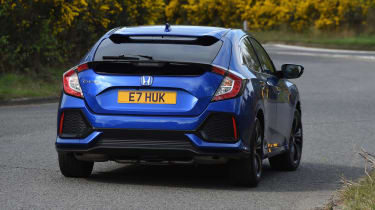Honda Civic hatchback (2015-2022) - Engines, drive & performance
The latest Honda Civic is enjoyable to drive and the new 1.0-litre turbocharged petrol engine is deeply impressive
The Honda Civic has long had a reputation as a rewarding car to drive and the latest version doesn’t let the side down. Next to its rivals, like the Volkswagen Golf and Peugeot 308, the Civic is the more fun car to drive, and is only bettered by the involvement found in the Ford Focus.
It’d be nice if there were a little more ‘feel’ through the steering, but ever since mainstream manufacturers switched from hydraulic to electric power steering setups to improve fuel efficiency, this has been a common complaint; the Civic is no worse an offender than any other car in this regard.
It’s still a responsive car, too, and there’s loads of grip in corners. Optional on some models – and standard on the EX and EX Sport Line – is an adaptive damping system that lets you stiffen the suspension to reduce the amount of body lean, but it doesn’t seem to achieve much aside from making the ride less comfortable, so we don't think it offers the same improvement as the Golf's adaptive suspension.
The manual gearbox is a joy to use, but we’re less keen on the CVT automatic. In many ways it does a good job, keeping engine speed down and saving fuel by using the engine’s pulling power rather than encouraging it to rev unnecessarily. However, it’s still rather unruly when you put your foot down to accelerate harder – revs soar and the car takes a long time to gain speed with corresponding vigour. It feels rather like driving a manual car with a slipping clutch.
More reviews
There are steering-column-mounted gearshift paddles like those on cars with a dual-clutch automatic, but the Civic’s CVT system doesn’t have any fixed gear ratios, so you don’t get as much manual control as you might like. We can only recommend the CVT for urban drivers or those who really need an automatic gearbox. Driven gently it’s relaxing and economical, but for enthusiastic driving the gearbox just doesn’t cooperate.
A separate complaint is that the Civic seems a little louder than we’d like, with wind and road noise disturbing the peace ever so slightly. This is more evident on higher spec cars, which are all fitted with 17-inch alloy wheels; hardly a vast diameter by modern standards.
Honda Civic petrol engines
A few years ago, a 1.0-litre petrol engine might have been found in a small city car, but would never have graced a family hatchback as substantial as the latest Civic. Today, however, turbocharging has become such a fine art we have no reservations in recommending the Civic’s smallest engine.
It develops most of its 124bhp high up in the rev range but, as the little three-cylinder engine is willing to be worked hard, accessing all that power is easy. Even when you don’t want to exploit its full capabilities, it’s a quiet companion that can be easily and quickly brought into life as and when required. Getting from 0-62mph officially takes 10.8 seconds.
It’s immediately apparent that the 1.5-litre four-cylinder engine is quieter than its three-cylinder counterpart. It doesn’t feel massively more responsive, though, despite its 180bhp, and if you choose the CVT automatic gearbox, some of the performance advantage over the 1.0-litre is negated by its dulled responses. Things are different with a manual gearbox, though, and the 0-62mph sprint is completed in a brisk 8.2 seconds.
Diesel engines
A 1.6-litre diesel engine was offered until autumn 2020. A heavily revised version of that fitted to the previous Civic, it’s a punchy performer, but it's rather louder than the petrol engines.
Which Is Best?
Cheapest
- Name2.0 eHEV Elegance 5dr CVT
- Gearbox typeAuto
- RRP£33,590
Most Economical
- Name2.0 eHEV Sport 5dr CVT
- Gearbox typeAuto
- RRP£35,165
Fastest
- Name2.0 VTEC Turbo Type R 5dr
- Gearbox typeManual
- RRP£51,410










